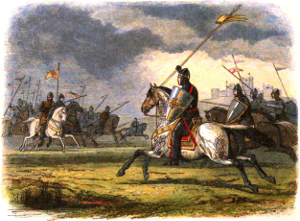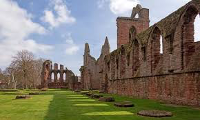King William the Lion of Scotland
King William the Lion was King of Scotland for 49 years. A charismatic, powerfully built man, William is known for his repeated run-ins with English monarchs and for founding one of his country's most famous abbeys. William's father was Henry, son of King David I. Henry died when William was 10, and William inherited the Earldom of Northumbria, a large area in northern England that David had gained as a concession from English King Stephen in 1139. David died in 1153 and was succeeded by William's older brother Malcolm. King Malcolm IV ruled for a decade and had several run-ins with the English Henry II, one of which removed William as Earl of Northumbria, in 1157. When Malcolm died in 1165, William became king. 
William was strong and headstrong and determined to recover Northumbria. He formed an alliance with France and also joined forces with Henry's sons when they revolted against him in 1173 and 1174. This culminated in the second Battle of Alnwick, which was a decisive victory for Henry. William was captured and taken away in chains, to various places around England then to Normandy. With William safely out the way, Henry headed up an army and occupied Scotland. William arranged his release by paying a huge ransom (which he gathered together by taxing his subjects) and signing the Treaty of Falaise. He swore fealty to Henry in 1175. Scots in Galloway rose up in response to William's humiliating defeat and display of fealty, and William spent 11 years putting down the revolt. William, aided by his brother David, had castles built to solidify their hold on power. In 1186, William married Ermengarde de Beaumont, a granddaughter of England's King Henry I. It was awhile before they had children. They finally had a son, Alexander, in 1198. This was the later King Alexander II. Henry II died in 1189 and was succeeded by his oldest son, who became King Richard I. This king was preoccupied with going on Crusade and offered to nullify the Treaty of Falaise if William would agree to pay a large of sum. William did, and Scotland was free of England's overlordship. William still had his eyes on Northumberland and offered to buy it from Richard in 1194; that bid was unsuccessful because Richard wouldn't give up the castles within it. Richard's successor, King John, moved an army to northern England in order to convince William not to invade Northumbria, and William took the hint. The two monarchs signed a treaty, part of the terms of which stated that William was to hand over his daughters to marry English nobles. A renewal of this treaty in 1212 promised that William's son, Alexander, would marry John's oldest daughter, Joan. 
William, like his grandfather, was a founder of abbeys and burghs. He founded Arbroath Abbey in 1178. (This would go on to become one of Scotland's most wealthy and well-known abbeys.) William died in 1214, having ruled for 49 years. He is Scotland's second-longest ruler (after James VI, who became King James I of England. William was buried at Arbroath Abbey, and his son succeeded him as king. The nickname "the Lion" was assigned to William after his death. He was a strong, powerful man with a mane of red hair. He also took as his standard a red lion. See also Early Medieval Scottish rulers. |
|
Social Studies for Kids
copyright 2002–2026
David White





